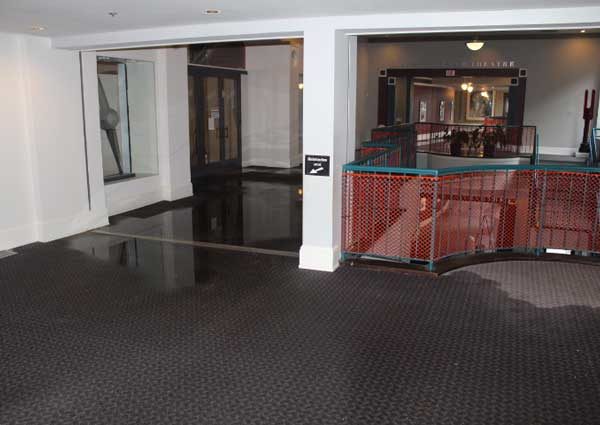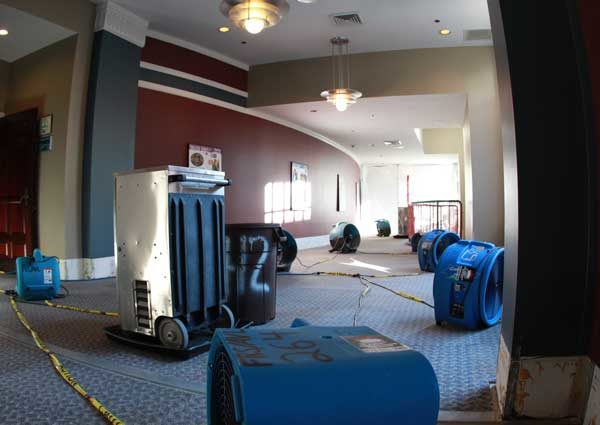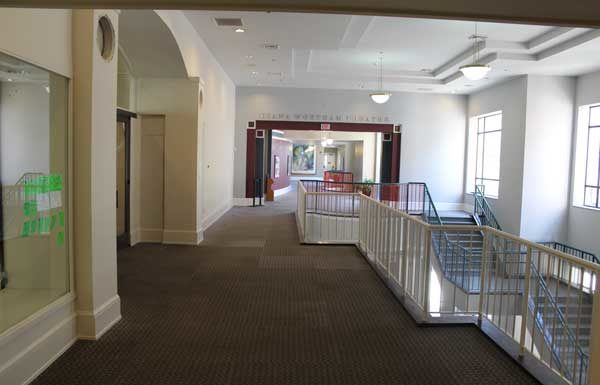The morning after the water damage, controlled removal permits were applied for. These permits require a third party company to test all materials that are to be removed.
Complexity #1 – Applying for controlled removal permits took three days. First Restoration Services could not do anything in removal until these permits were received, putting a delay on the start of the removal process.
In the meantime, we tracked moisture level readings and output readings on drying equipment, monitored overall drying process and set up containment for controlled removal.
The public facility where this incident occurred houses three organizations who provide cultural programs seven days per week, throughout the day and in the evenings. First Restoration Services had to safely accommodate the use of the facility for these programs for both students and adults. For example, before First Restoration Services could take the next step in the mitigation phase, we needed to remove all equipment from the first floor public areas to accommodate one of the cultural activities scheduled. Following the event, First Restoration Services placed all equipment back in its proper place to resume drying.
Complexity #2 – By having to remove the equipment to accommodate the needs of a joint facility open to the public with ongoing activities, we were delayed completing the project. The Museum Director recognized this and appreciated the flexibility we had shown in working toward the least possible disruption of staff and public programs.
With the permits in hand, we began the controlled removal process. We started in the shared public areas which were of high importance to the Museum Director, Pam Myers. During this process, proper engineering controls were established: HEPA Vacuuming, Containment, Negative Pressure w/ HEPA Filtration & Floor Protection.
During the removal process, the carpet tiles first had to be top dried, then shimmed and turned over without losing their existing position, then dried again on the other side. Complicating matters, all baseboards had been screwed in rather than nailed, making the process of removal more challenging.
Complexity #3 – The third complexity facing First Restoration came during the drywall removal. Technicians found anywhere from two to five layers of drywall whereas, typically, there is only one layer to be removed. One reason for the numerous layers was for fire protection.
 Emergency
Emergency Residential Restoration
Residential Restoration Commercial
Commercial Water Removal
Water Removal Water Damage
Water Damage Water Damage Repairs
Water Damage Repairs Flood
Flood Sewage Cleanup
Sewage Cleanup Fire Board
Fire Board Fire Damage
Fire Damage Smoke Damage
Smoke Damage Commercial Water Damage
Commercial Water Damage Commercial Fire Damage
Commercial Fire Damage Mold Inspection
Mold Inspection Mold Removal
Mold Removal Wind
Wind Specialty
Specialty TOMI
TOMI Crime Scene
Crime Scene Case
Case Helpful
Helpful ERP Client
ERP Client Construction
Construction Kitchen
Kitchen Bathroom
Bathroom Home
Home Office
Office Book Remodel
Book Remodel About
About Contact Us
Contact Us Our Story
Our Story Events
Events Media
Media FAQ
FAQ Apply Now
Apply Now Careers
Careers Plumber Referral
Plumber Referral All Posts
All Posts Cleaning
Cleaning Commercial
Commercial Schools & Colleges
Schools & Colleges Churches
Churches Healthcare Facilities
Healthcare Facilities Senior Living Homes
Senior Living Homes Government Municipalities
Government Municipalities Hospitality
Hospitality Industrial
Industrial Multi-Family Housing
Multi-Family Housing



 Emergency Services
Emergency Services
